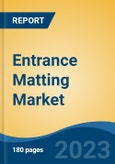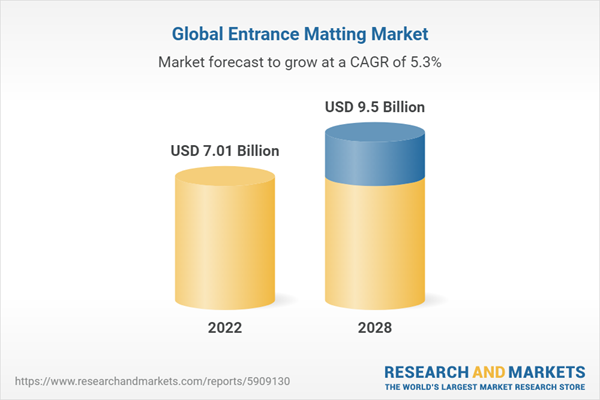Speak directly to the analyst to clarify any post sales queries you may have.
10% Free customizationThis report comes with 10% free customization, enabling you to add data that meets your specific business needs.
Entrance matting serves as the initial line of defense against dirt and contaminants, especially in high-traffic areas such as public buildings, offices, hospitals, and retail spaces. These mats effectively reduce the ingress of dirt and moisture indoors, minimizing the need for frequent cleaning, preserving floor surfaces, and extending the lifespan of interior flooring.
Several key factors drive the entrance matting market's growth. Urbanization and population growth have led to increased foot traffic in various facilities, underscoring the necessity for efficient dirt and moisture control solutions. Furthermore, heightened awareness of hygiene and safety has prompted businesses and homeowners to prioritize cleanliness and minimize slip hazards.
The entrance matting market offers a diverse range of products tailored to different needs. This encompasses recessed mats, surface-mounted mats, and specialized mats designed for specific purposes, such as anti-fatigue or logo customization. The industry has also witnessed technological advancements, including the integration of sensor systems to monitor foot traffic and assess mat cleanliness.
Both commercial and residential sectors significantly contribute to the entrance matting market. In commercial spaces, entrance matting forms an integral part of the overall maintenance and safety strategy of a building, safeguarding flooring investments and reducing maintenance costs. In residential settings, aesthetic considerations often combine with practicality, driving demand for matting that complements interior design while effectively trapping dirt and moisture.
The growing environmental awareness has propelled the adoption of sustainable entrance matting materials, encompassing recycled fibers and biodegradable components. Eco-friendly entrance matting aligns with the sustainability goals of businesses and homeowners while providing functional benefits.
Key Market Drivers
1. Emphasis on Safety and Floor Protection: The primary driver of the global entrance matting market is the growing emphasis on safety and floor protection. Entrance matting serves as the initial line of defense against dirt, moisture, and contaminants that can be tracked into buildings from the outside. Businesses and institutions increasingly recognize the importance of maintaining a clean and safe environment for employees, visitors, and customers, making entrance matting an essential component of facility management strategies.2. Aesthetic and Branding Considerations: The aesthetic appeal and branding potential of entrance matting are driving significant innovations in the market. Businesses and organizations understand that entrance areas offer an opportunity to make a strong first impression on visitors. Entrance matting systems can be customized with logos, colors, and designs that align with a company's brand identity. Additionally, entrance mats are now seen as an extension of interior design, contributing to the overall ambiance of a space and complementing decor and architecture.
3. Focus on Sustainability and Indoor Air Quality: Sustainability has emerged as a significant driver in the entrance matting market, fueled by growing awareness of environmental impact and indoor air quality. Many entrance mats are now designed with eco-friendly materials that are recyclable and contribute to waste reduction. Sustainable entrance matting solutions align with corporate social responsibility initiatives and resonate with environmentally conscious consumers. Furthermore, the role of entrance matting in maintaining indoor air quality has gained attention, with mats designed to capture and trap pollutants, allergens, and particulates brought in from the outdoors.
Key Market Challenges
1. Maintenance and Longevity: Ensuring the proper maintenance and longevity of entrance mats poses a significant challenge. Frequent cleaning and maintenance are essential to prevent the buildup of dirt and moisture, which can lead to mat deterioration and an unhygienic appearance. Improper cleaning techniques or infrequent maintenance can result in a shorter mat lifespan, reducing their effectiveness over time. Educating customers about proper maintenance practices and providing guidelines for effective cleaning can help extend the lifespan of entrance mats.2. Customization and Aesthetic Integration: Entrance matting is not just a functional element but also contributes to the overall aesthetic of a space. Achieving customization while maintaining functionality can be challenging, as custom mats might require specific sizing, colors, and branding, which can complicate the manufacturing and supply chain processes. Manufacturers can leverage technology to offer customization options without compromising on quality and functionality, streamlining the customization process and offering a wide range of design choices to address this challenge.
3. Safety and Slip Resistance: Ensuring slip resistance without compromising aesthetics can be challenging. Mats that are highly slip-resistant might not always align with the visual preferences of customers or the design of the space. Manufacturers need to strike a balance between slip resistance and aesthetics through the use of innovative materials and design techniques that provide effective traction while offering a visually appealing surface. Regulatory compliance and adherence to safety standards are also essential to maintain customer trust and ensure the safety of building occupants.
Key Market Trends
1. Technological Advancements and Innovative Materials: Entrance matting solutions are evolving with technological advancements and innovative materials. Entrance mats now integrate advanced technologies and materials to offer enhanced functionality and improved user experiences. Sensor-based systems can detect foot traffic and adjust mat properties accordingly, while innovative materials like anti-fatigue polymers and eco-friendly components are transforming the market landscape. These materials provide ergonomic support, reduce physical strain, and contribute to sustainability goals.2. Customization and Branding for Aesthetics and Corporate Identity: Entrance matting has become an integral part of corporate branding and aesthetics. Customized entrance matting solutions are in demand, incorporating logos, slogans, and designs that align with a company's brand identity. This customization extends to functional considerations, such as enhanced slip resistance or anti-microbial properties. As businesses seek distinctive entryways that align with their values and image, the entrance matting market offers a wide range of design and performance options.
3. Focus on Safety, Hygiene, and Indoor Air Quality: Safety, hygiene, and indoor air quality are significant trends shaping the entrance matting market. Entrance mats are designed with anti-microbial and anti-bacterial properties, inhibiting the growth of harmful microorganisms and contributing to a cleaner and healthier environment. Some mats capture airborne particles, enhancing indoor air quality. Sustainability and ease of maintenance also play a crucial role, with mats that are easy to clean and maintain contributing to overall facility cleanliness and reduced use of cleaning chemicals.
Segmental Insights
Type Insights
The global entrance matting market prominently features anti-fatigue entrance matting, a segment that has gained a substantial share due to its unique properties and diverse applications. Anti-fatigue entrance matting has become integral to addressing evolving consumer needs, workplace safety concerns, and the integration of technology to improve indoor environments.Increasing awareness of workplace health and safety has driven demand for anti-fatigue entrance matting. These mats alleviate the physical strain and fatigue experienced by individuals who stand for prolonged periods, enhancing employee comfort, well-being, and productivity. This aligns with the emphasis on creating ergonomic work environments that prioritize worker health.
Anti-fatigue entrance matting finds applications across various sectors, from industrial settings to commercial spaces. In manufacturing facilities, warehouses, and retail environments, employees often stand
for extended durations, leading to fatigue and discomfort. The integration of anti-fatigue matting helps mitigate these issues, resulting in improved work efficiency and reduced absenteeism due to discomfort-related concerns.The retail and hospitality sectors prioritize the use of anti-fatigue entrance matting to enhance the experience for employees who spend significant time on their feet, ensuring they can provide exceptional service to customers. Companies are recognizing the correlation between employee satisfaction and business success, making investments in anti-fatigue entrance matting to signal their commitment to employee well-being, leading to increased job satisfaction and improved workplace morale.
Health and safety regulations emphasize providing ergonomic solutions to address workplace discomfort and fatigue, making anti-fatigue entrance matting an essential component of compliance strategies for businesses seeking to ensure a safe and comfortable work environment.
Application Insights
The residential sector plays a significant role in the global entrance matting market. Entrance mats are essential for maintaining cleanliness, preventing dirt, dust, and moisture from entering buildings, enhancing safety, and creating a welcoming environment for residents and guests.The global entrance matting market is expected to witness substantial growth, with the residential sector projected to contribute significantly. Factors such as increasing urbanization, rising disposable incomes, and growing awareness of maintaining clean and hygienic living spaces drive this growth. Entrance mats designed for residential use come in various styles, sizes, and materials, catering to different preferences and needs. They not only help in trapping dirt and moisture but also add aesthetic appeal to the entrance area of homes.
As individuals prioritize cleanliness and interior aesthetics, the demand for high-quality entrance matting products in the residential sector is expected to rise. Additionally, the inclusion of eco-friendly and sustainable materials in entrance mats has gained traction, further fueling market growth. Overall, the residential sector holds substantial promise in the global entrance matting industry, with its growth expected to continue in the foreseeable future.
Regional Insights
The Asia Pacific region commands a significant share of the global entrance matting market. Entrance mats are widely used across various sectors in countries such as China, India, Japan, and South Korea, driven by rapid urbanization, commercial infrastructure development, and a growing awareness of hygiene and safety.Factors such as increasing disposable incomes, the need for effective floor protection in high-traffic areas, and heightened awareness of hygiene and safety contribute to the expansion of the entrance matting market in the Asia Pacific region. Additionally, the hospitality and tourism industry plays a crucial role in driving demand for entrance matting products in hotels, resorts, restaurants, and other establishments to create a positive first impression for guests and provide a clean and safe environment.
In addition to commercial applications, the residential sector in the Asia Pacific region contributes significantly to the entrance matting market. As more individuals focus on maintaining cleanliness and aesthetics in their homes, the demand for entrance mats for residential use continues to grow.
Overall, the Asia Pacific region holds a substantial presence in the global entrance matting market, driven by factors such as urbanization, commercial development, tourism, and increasing awareness of hygiene.
Report Scope:
In this report, the global entrance matting market has been segmented into the following categories, in addition to the industry trends which have also been detailed below:Global Entrance Matting Market, By Type:
- Walk-Off
- Anti-Fatigue
- Logo
- Specialty
Global Entrance Matting Market, By Material:
- Nylon
- Coir
- Rubber
- Vinyl
- Jute
- Cotton
- Velvet
- Others
Global Entrance Matting Market, By Application:
- Residential
- Non-Residential
Global Entrance Matting Market, By Region:
- North America
- United States
- Canada
- Mexico
- Asia-Pacific
- China
- India
- Japan
- South Korea
- Australia
- Europe
- Germany
- France
- United Kingdom
- Italy
- Spain
- South America
- Brazil
- Argentina
- Colombia
- Middle East & Africa
- Saudi Arabia
- UAE
- South Africa
- Turkey
Competitive Landscape
Company Profiles: Detailed analysis of the major companies present in the global entrance matting market.Available Customizations:
Global Entrance Matting Market report with the given market data, the publisher offers customizations according to a company's specific needs.This product will be delivered within 1-3 business days.
Table of Contents
Companies Mentioned
- Superior Manufacturing Group
- Unifirst Corporation
- 3M Company
- Advance Flooring Systems
- Bergo Flooring AB
- Birrus Matting Systems
- Cintas Corporation
- Eagle Mat & Floor Products
- Forbo Holdings AG
- Milliken & Company
Table Information
| Report Attribute | Details |
|---|---|
| No. of Pages | 180 |
| Published | November 2023 |
| Forecast Period | 2022 - 2028 |
| Estimated Market Value ( USD | $ 7.01 Billion |
| Forecasted Market Value ( USD | $ 9.5 Billion |
| Compound Annual Growth Rate | 5.3% |
| Regions Covered | Global |
| No. of Companies Mentioned | 10 |









